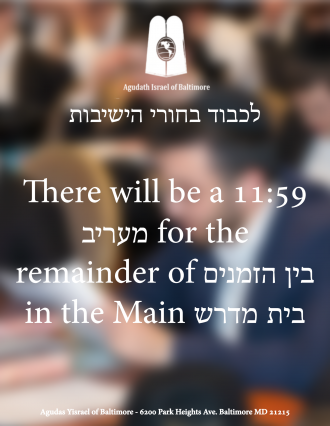Technology & Your Relationships: Overcoming Connectivity to Connect [1]
Relationships have been changed forever.
Technology has had a profound impact on relationships between friends, family and spouses. It has allowed for ease and frequency of communication between people physically apart and has introduced people who would otherwise never have met, creating marriages, friendships and invaluable support groups and relationships.
Yet technology has also negatively impacted how we relate to each other in ways that we all experience and notice, and that has been observed - both anecdotally and in formal studies - by professionals in the field of relationships. We shall explore three broad components of this negative impact and steps we can take to address them.
I. Absent Presence
“Absent Presence” can be observed in conversations, meetings and classes where participants zone in and out of the interaction they are ostensibly engaged in, as they respond to a ping or a buzz, or initiate a quick message check of their phone or screen. And you can see it in family rooms, cars, doctors’ offices and check-out lines, where interactions that would otherwise have occurred do not end up happening, as each party is absorbed in their own technological world. Whereas AT&T used to promote its long distance telephone service by exclaiming that a phone call is “the next best thing to being there,” we would now declare that being there with your smart phone is “the next best thing to truly being there.”
On an immediate, interpersonal level, the impact of absent presence is both real and perceived. The reality is that the quick glance at an incoming text message does zone us out of the current conversation such that we miss out on important elements of the exchange. And the hurtful, yet accurate perception is that whomever we are speaking with is apparently not deserving of our full and undivided attention.
A meaningful spousal relationship is predicated on a strong sense of the exclusivity of that relationship. A productive parental relationship grants the child the gift of self-worth gleaned from seeing and knowing that - to their parent at the very least - there is nothing and no one more important. Any friendship or relationship is nourished by focus and attention. Technology’s unlimited capacity to interrupt all our interactions robs our relationships of the exclusive focus that is their lifeblood.
A study on “The iPhone Effect” found that “conversations in the absence of mobile communication technologies were rated as significantly superior compared with those in the presence of a mobile device… People who had conversations in the absence of mobile devices reported higher levels of empathetic concern.” The mere presence of a mobile device on the table – even one that was not ringing or buzzing or looked at – had a tangible, negative effect on the quality of conversation (Misra et al, 2014).
This effect appears similar to the Halachic mechanism of keeping an open door to avoid the prohibition of Yichud (being secluded with a member of the opposite sex). It appears that the open door does not only provide a practical safeguard by increasing the likelihood of being caught in the act. Closing the door is a clear commitment to privacy and exclusivity that actually creates a tangible, intimate bond. That same bond is created when a parent, spouse, friend or colleague puts away his or her device at the outset of a conversation.
Years – and technological generations – ago I recall hearing Rabbi Ephraim Buchwald amusingly describing the different couples he would observe walking in the park across from his Manhattan window. The couple walking with their earphones in, each listening to their own Sony Walkman, were obviously not in love. On the other hand the couple whose earphones were plugged in to the same Walkman were clearly madly in love with each other.
As facetious as this description is about the quality of relationships, there is something to be said for two people – or a family – sharing an experience, even in utter silence. Yes, a family sitting in the living room watching a movie together is not interacting nearly as well as they could. But today’s family isn’t even watching the same screen! How often do you pass a car where the couple inside is speaking to each other? It is far more common to see the spouse slumped in the passenger seat, staring at a smart phone screen or speaking into it.
Ultimately, connectivity has collapsed the walls of our homes, allowing us access to infinite valuable resources, but at the same time allowing us to unconsciously wander away from the comfortable and intimate confines of home and family, and to welcome others in at any and all hours.
It is clear that we can and must reclaim that attentiveness and intimacy by making the choice to simply put away our devices during the time we have with each other.
II. The Empathy Gap
We noted in the first essay in this series (Technology and You: Stopping the Unstoppable), that the story of our bondage in Egypt starts on some level at the beginning of Parshas Vayechi, where Rashi noted that the Parsha is not separated from the previous one by the usual break, the usual empty space in the scroll. This is an indication that around the time of the death of Yaakov, “the eyes and hearts of the Jewish people were closed by the difficulties of the bondage.”
The choice of words is striking: “the eyes and hearts of the Jewish people were closed by the difficulties of the bondage.” This is a direct contrast to the portrayal of the reactions of both G-d and Moshe, who are described as opening their eyes and hearts to the suffering of the Jewish people (see Rashi Shemos 2:11, 2:25). Evidently, the busyness of a life without breaks causes us to withdraw into ourselves and lose the ability to notice what is going on around us.
A contemporary writer, William Bunn, used the painful term “Technological Autism” for the phenomenon of technology users’ obliviousness to what is going on around them. This can certainly be seen to some degree as more of the same “absent presence”, but it goes beyond distractedness. There is a depth to human relationship that can only be perceived and appreciated through real and tangible human contact. Even in a business context, airplanes are filled with corporate travelers because they know that negotiations or relationships conducted by phone, text and e-mail lack the depth of communication and understanding created in person.[2]
In a study that compared the post-trauma effects of the calming sound of a mother’s voice to a similarly comforting text message, it was clear that the chemically measurable positive effects of the human voice far surpassed that of the text message (Seltzer et al, 2012). Clearly, not all communication is created equal. The more we employ our actual physical selves in communication, the more we connect with each other and feel the profound power of relationship.
Yet current trends amongst young people are moving in the opposite direction, resulting in a serious, documented reduction in eye contact during interpersonal conversation. The preponderance of alternative methods of communication has apparently resulted in a diminished utilization and appreciation of the potential depth of interpersonal relationship.
Sherry Turkle is a sociologist and psychologist who serves as a professor of the Social Studies of Science and Technology at MIT. She is also a celebrated author of a number of studies on our relationship with digital culture, most recently, “Reclaiming Conversation” (Penguin 2015). In describing her many consults with schools, she notes an inability in many students to relate to each other, or to understand each other. The faculty sees their students as emotionally underdeveloped, lacking the experience and skills of relating by looking at and understanding one another.
The good news is that studies have shown that these are skills that can be created or restored with a relatively short period of device-free interaction. And we, as Jews, are blessed with Shabbos, a gift that provides us with just such a window of warm and genuine person-to-person interaction.
Yet as valuable as Shabbos is, it is not enough. We can and must make the choice to proactively pursue direct human interaction. We must reserve the text message for housekeeping issues and similar technical details that need to be shared, but not as a substitute for quality conversation. We must ensure that our relationships are direct and personal, with plenty of eye contact and a real feel for one another.
III. The Two-dimensional Relationship and the Impact of Pornography
A discussion of technology and relationships must include some mention of the unfortunate but widespread phenomenon of internet pornography use and addiction.
The Internet is a huge source of free and accessible pornography, encountered both by those searching for it and those who stumble across it accidentally. A casual search of the statistics on this phenomenon produces staggering results (e.g. 25% of all search engine requests are pornography related, as are 35% of all internet downloads). Anyone working in the fields of education, counseling or the clergy can attest to its growing impact on every population.
Exposure to this kind of material – even for those not addicted to it – can have a negative, transformative effect on current and future relationships. First and foremost it presents the members of the opposite sex as two-dimensional objects, with an emphasis on external appearance, rather than as real and deep people, valued for their character. It encourages the view of sexuality as something pursued for ourselves, rather than as the ultimate expression of relationship with another. And it creates strange, humiliating, and often lasting expectations of what should occur in the bedroom.
This phenomenon can be addressed by prevention and intervention. Classic prevention strategies include filters, usage in public places, and inviting outside monitoring through family and friends. Interventions for occasional users would involve seeking support from friends or mentors, or from groups such as Guard Your Eyes, while addicts require professional help and SA groups.
Filling the Void: Experiencing Rich Relationship
Yet the ultimate strategy for dealing with the pornography issue, as well as with the issues of absent presence and the empathy gap, is a far more positive and proactive approach that works to fill the space otherwise addressed by these behaviors.
Rambam, when writing about the challenges of maintaining proper sexual morality in thought and in deed, concluded his discussion by noting that these challenges find space in a heart that is empty of wisdom, whereas one who pursues the wisdom of Torah will find that it occupies his heart and is the object of his passion (Rambam’s conclusion of Hilchos Issurei Biah).
While the Rambam is espousing the ideal of a passion for Torah, it is similarly the case that a heart filled with passion for any positive thing, and most especially with the passion of a positive relationship, will be less open to being filled with the Internet’s unseemly content. Our greatest prevention strategy for avoiding engagement in the negative is active pursuit of the positive. The delicious taste of the satisfying beats the other stuff anytime. And that taste is the enchanting flavor of genuine presence and empathetic connection.
A Plan of Action: We can and must take specific actions to restore the strength of our relationships in a way that will have a good chance of succeeding in the longer term. As noted in Part I, we must follow the usual rules for effecting lasting change, i.e. to undertake specific, modest and manageable commitments, and to have a support system for implementing and maintaining them.
We can start with three simple changes:
1. Off Times: The same strategy of limits that we discussed earlier is unquestionably a staple of any strategy to deal with the impact of technology on our relationships. It is necessary for us to have dedicated off times, and to put away technology when we are with others who deserve our focus and undivided attention. To gain family buy-in, support and accountability, we can designate a box or drawer where family members agree to place their phones before meals and times together. As noted earlier, there is no doubt that we will be thrilled with any such break we succeed in carving out for ourselves. We will not regret having established this space; we will only regret that it took us this long to do it.
2. Find fulfillment in your relationships: The thrill of reconnecting to our spouse, children and friends will provide the greatest prevention strategy for the future, as the ultimate game-changer will not be the imposed limitation but the positive feeling that takes its place. Look in your children’s eyes; look long and hard in your spouse’s eyes. You will see trouble and distraction if it is there. But even more important, you will connect and relate to each other, and you will enjoy it.
3. Remind and inspire yourself: A popular writer on this subject is Rachel Macy Stafford, author of books as well as a blog known as “Hands Free Mama.” Her simple inspirational stories and practical ideas serve to reinforce the immediate and tangible rewards of “letting go … to grasp what really matters.” Works like these are worth reading to remind us of the values we all hold dear and need encouragement to pursue.
Reclaiming connection from the clutches of connectivity is no simple task, but it is eminently doable, and its rewards will be immediate and enormously satisfying. Go for it!
[1] This article is Part II of a three part series on our relationship to technology. This article draws upon much wisdom gleaned from others, most notably the thoughts and research cited in the current (Fall 2015) issue of Klal Perspectives, dedicated to the subject of technology. The reader is encouraged to read the entire issue, and to accept this general citation for much of what is included here.
[2] This reality is an important one to keep in mind in developing courtships. One of the blessings of communication has been its facilitation via online services of the introduction of numerous couples who otherwise would have been unlikely to meet. It is, however, of vital importance that the introductions made via technology do not become relationships forged by technology. It would be wise for couples to prevent their relationship from developing greatly electronically, because so much is missing when the real feel of the other’s presence is absent. A couple can create a deceptively deep and intense electronic relationship where the personal meeting is seen as a final detail, a confirmation of the relationship they have already built online. In fact however the personal meetings and interactions need to be the beginning and the heart of their relationship, as they will ultimately be living with each another.


















